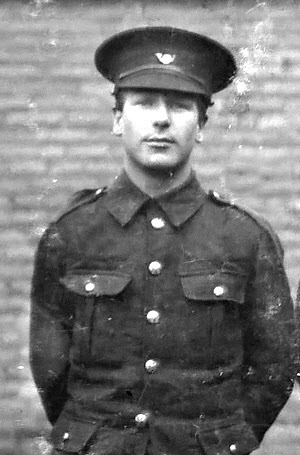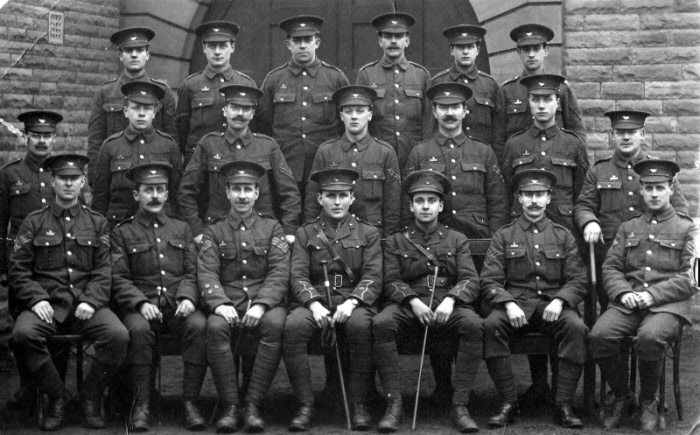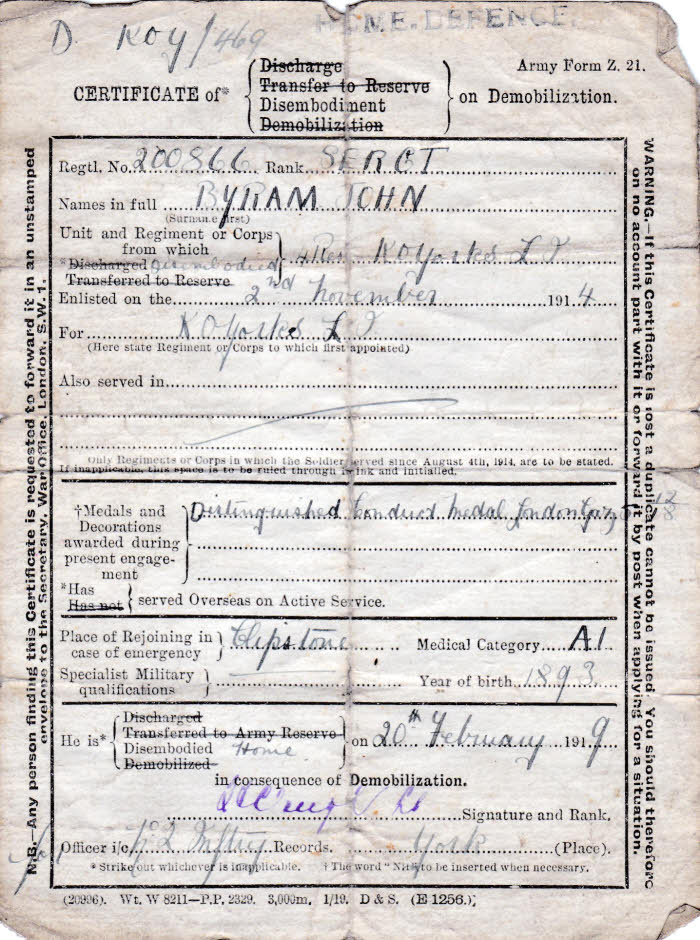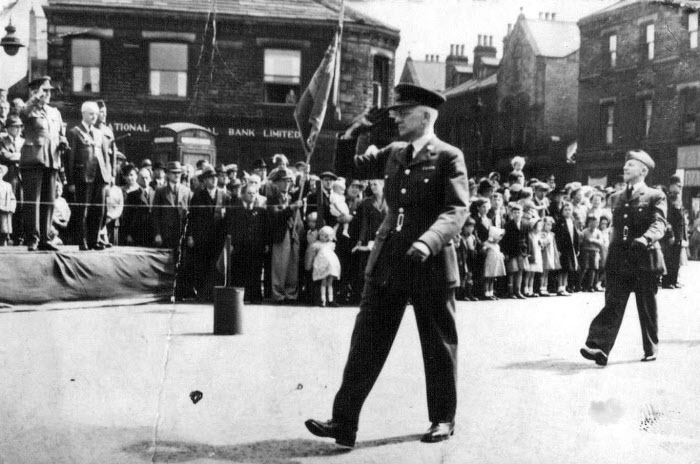
DCM, 200866, 2/4th Battalion, King’s Own Yorkshire Light Infantry, T.F. (Middlestown).
John (Jack) William Byram was born on the 12th March 1893 at Coxley, Horbury Bridge, the illegitimate son of John Moorhouse Day (born 26th June 1870 in Fulstone, Huddersfield) and Mary Ellen Byram (born 1870, in Lockwood, Huddersfield). In 1891, the Day family and the Byram family were close neighbours, both living at Coxley, near Middlestown. 20 year-old John M. Day was working as an overlooker’s assistant in a woollen mill. Mary Ellen Byram also gave birth to a daughter at Coxley in 1895, who was christened Lena Byram, but was later known as Lena Day, so presumably the father was John Moorhouse Day.
The Day family later moved to Mirfield and John M. Day married Mary Ellen Exley at St. Mary’s Church, Mirfield on the 10th August 1901. By 1911 the couple were living in Birkby, Huddersfield with two young sons and John Day was employed as a scribbling engineer in a mill. John Byram’s father, John Moorhouse Day died in Huddersfield in 1946 aged 76 years.
John’s mother, Mary Ellen Byram married pit labourer Wilfred Popplewell in 1902 in the Wakefield area and they had a son Leonard Popplewell in 1909. In 1911, the Popplewell family were living at Middlestown with cloth finisher John William (18) and Lena (15), now recorded with the surname Day, plus 18 month-old Leonard Popplewell. In May 1913, Mary Ellen Popplewell died at the age of 42 years in the Thornhill, Dewsbury area. In 1939, Leonard Popplewell was serving time in Leeds Prison and died aged 36 years in 1946 in the Horbury area. It is thought that Lena died in her late teens from TB, and is buried in Thornhill church cemetery.
John Byram enlisted with the 1st/4th Battalion of the King’s Own Yorkshire Light Infantry on the 2nd November 1914 with the service number 4006 (later 200866 with the 2nd/4th Battalionn KOYLI ). He went to the Western Front, France in April 1915. There is a record of him being discharged on the 6th May 1916, and it is possible that he joined the Army as part of the 2nd/4th Battalion of KOYLI at some time later or was transferred.
The “London Gazette” dated the 5th December 1918 records the award of the Distinguished Conduct Medal to Sergeant J. Byram as follows:
“200866 Sjt. J. Byram, 2/4th Bn., KOYLI, T.F. (Middlestown). Acting as C.S.M. during operations, he carried out his duties with conspicuous courage and ability. During an attack he charged a machine gun with his company commander, who was killed almost immediately, but he captured the position single-handed, bayonetting the team. Throughout, he never ceased to cheer his men, and his example of courage and devotion to duty was of a very high order.”
Jack Byram’s service records that before he won the DCM in 1918, he was wounded in August 1917 whilst out on patrol. His medical record states “gunshot wound to the right leg and buttocks”. He was evacuated on the hospital ship “SS Essequibo” on the 15th September, and after spending some time in the Casualty Clearing station and base hospital, he was eventually treated in Bethnal Green hospital in London. Due to the German Spring offensive in March 1918, Sergeant Byram was once again sent out into the front line, after it was decided that he had recovered sufficiently from his wounds.
2/4 Battalion K.O.Y.L.I. was taking part in operations against Vraucourt, North East of Bapaume. They assembled to the east of the railway line near L’Abbaye on the outskirts of Mory. The objective of 2/4 Battalion was a German trench system to the North of a sugar factory close to the Divisional boundary. A Grenadier Guards battalion flanked the KOYLI Battalion.
The German trenches were arranged with Maxim machine guns firing on mutually supporting arcs. When the attack went in, Byram was at this time acting Company Sergeant Major and was with the ‘D’ company commander, 22 year-old Captain Geoffrey Skirrow1, plus the company runner Henry Beaumont (who was also from Coxley). The German Maxim machine gun fire played across the front of both the Guards battalion and 2/4 K.O.Y.L.I., bringing both advances to a halt after about 500 yards. At this point both CSM Byram and Captain Skirrow were hit. CSM Byram in the same leg and thigh area in which he had received his previous wound. Sadly, Capt Skirrow’s wound proved to be fatal.
Byram’s next action was to bring up one of the battalion’s Lewis gun teams. In 1917, the typical British infantry Company had up 16 Lewis guns on full time strength. He directed the team to fire on the front of the Maxim MG position to try and suppress their fire. CSM Byram at this point ran forward. Whether this was a lone run or with the remains of the company it isn’t known, although the reports state that he took charge since there were no officers left or available. It is likely that he flanked the German machine gun position, otherwise he would have been in full view of the Germans as he charged forward. It is unlikely that the Germans would have sat idly by watching, so he must have seen a blind spot or dead ground that he could utilise.
The official citation states that CSM Byram took out the machine gun post by simply bayonetting the team. In theory the German machine gun team will have consisted of at least three or possibly four men (Gunner, Loader, Officer and/or NCO in charge), which suggests that he took them by surprise.
In his own words, Jack Byram said the Germans “screamed like Jays” as he bayonetted them. British training doctrine at that time was based around the use of the bayonet in close assault and Byram would have trained extensively on bayonet drill using either a Lee Metford or SMLE rifle and 17 inch bayonet.
With that interlocking arc of MG fire removed, the attack then succeeded, even though they were still outnumbered and only 24 men out of the company made it to the German trench line to try hold what they had taken. However, they were so small in number they had to retire back to their original positions. It is thought that this action when John Byram won his DCM took place on the 27th August 1918.

Above: John William (Jack) Byram (second from right, top row) with his K.O.Y.L.I. Battalion in 1914/15. Picture courtesy of Gerard Byram.
Sergeant John William Byram was “disembodied” from the Army on the 20th February 1919, which is much the same as being demobbed. For any Territorial Force unit to go overseas it needed to be “Embodied to go to War” (the TF was for the defense of the UK). At the end of the War the unit or soldier would have to be “disembodied”. This did not apply to the Regular Army soldiers.

Above: Sergeant Byram’s Certificate of Disembodiment dated 20th February 1919. He was awarded the 1915 Star, British and Victory Medals as well as the DCM. Picture courtesy of Gerard Byram.
After his WW1 service, Jack Byram married Eleanor Mary (Nellie) Callaghan (born 22nd May 1896) in the December quarter of 1920 at St Ignatius Church, South Ossett. They had six children in 17 years. Nellie Byram died in March 1975 in her hometown of Ossett at the age of 78. In the 1939 Register, the Byram family lived at 11, Victoria Street, Horbury Road, Ossett and John Byram was working as a rag carboniser. Jack Byram was also an accomplished church organist.

Above: During WW2, Jack Byram joined the A.T.C. and took part in the VE day parade in Ossett at the end of the war. He is shown in the picture above marching behind the officer commanding. Picture courtesy of Gerard Byram.
John William (Jack) Byram died on the 5th January, 1968, in Wakefield, Yorkshire, England, at the age of 74.
Our thanks to Gerard Byram, the grandson of John William Byram who provided much of the detail of his grandfather’s war service, especially the action at Bullecourt Wood where he was awarded his DCM. The eldest son of John William Byram, Thomas Byram (who was in the navy during WW2) was very helpful in collating his father’s war service, but sadly he has since passed away. Gerard Byram received all the family paperwork and photos in Thomas’ will, which included photos of John William Byram and his citation plus paperwork from when he was wounded and his discharge papers, etc. John Byram didn’t speak about the DCM action much according to Thomas Byram, but they managed to piece together a full account over the years.
References:
1. SKIRROW Captain Geoffrey Skirrow, Croix de Guerre. Aysgarth School, Harrow and Clare College Cambridge. ‘C’ Company Commander and patrol leader in the 2/5th Battalion West Yorkshire Regiment and later ‘D’ Company Commander, 2/4 K.O.Y.L.I. Killed by machine gun fire on the 27th August 1918 aged 22 years. Buried Mory Abbey CWGC. Nec Aspera Terrent. Born Headingley, Leeds.